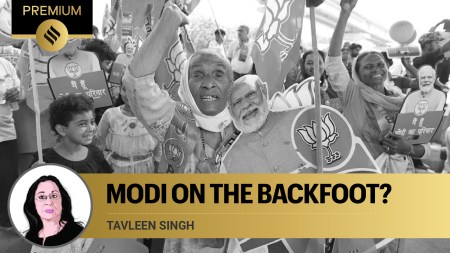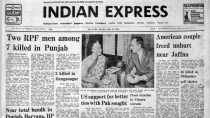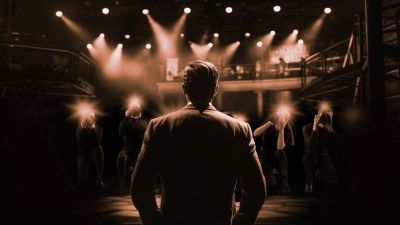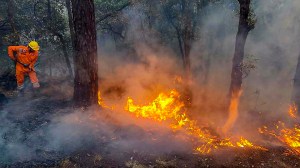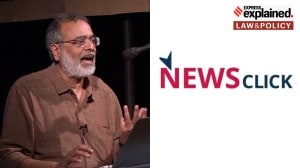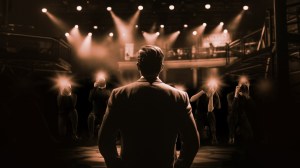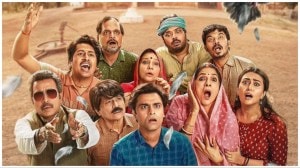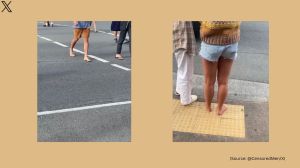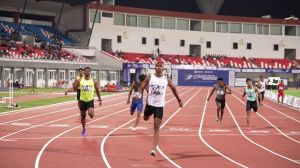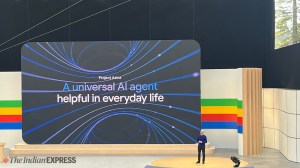- India
- International
Gieve Patel, the artist, the truth-teller
His intense forensic examination of violence impelled him to recognise its roots in the divisiveness of antagonistic identities. He committed himself to ideas rather than ideologies.
 Gieve Patel intense forensic examination of violence impelled him to recognise its roots in the divisiveness of antagonistic identities.
Gieve Patel intense forensic examination of violence impelled him to recognise its roots in the divisiveness of antagonistic identities. In one of the photographs on my phone, I find our dear friend Gieve Patel exploding into hearty laughter. He had been regaling us with stories that were, as they always wonderfully were with him, part art-history lesson and part art-world gossip. Gieve, who has passed away at the age of 83, had a flair for the dramatic. Or, more correctly, for the emphatic. Whether he was painting, or reciting his poems or writing art criticism or plays, his stance was resolutely stated in a fearless and unsentimental manner. He exhibited his paintings for the first time in 1966 at the Jehangir Art Gallery and quickly emerged as a thoughtful critic wrestling with the question of the place and role of art in a newly-independent country. Between the 1960s and 1980s, while Indian artists and critics were grappling with the dominant paradigm of indigenism, Gieve argued against both the myopia of nativism and the potential vacuity of an unexamined internationalism (‘Contemporary Indian Painting’, 1989). At a moment in history when many of his colleagues were taking up sharply opposed positions in a polemical exchange, Gieve committed himself to ideas rather than ideologies.
As I ponder over the compelling images that we associate with Gieve’s art, I see a peacock’s plume grazing an office ledge in Nariman Point, a swan taking off from a water tank in Nargol, rural Gujarat. I see thirsty buffaloes, crafty crows, rats smashed by vehicle tyres, crushed human heads, sockets missing eyes, eyes missing love, faces shaped like open wounds, wounds thriving like deranged ecologies in miniature. Violence and vulnerability, brokenness and resilience: The human condition perennially preoccupied the good doctor, who used his scalpel to make small incisions in reality.
The same year that Gieve debuted as an artist, his first book of poems was published by his mentor, the poet Nissim Ezekiel. By Gieve’s own admission, his first exhibition was apprentice-level work – imitations of Akbar Padamsee’s nudes. By contrast, I would argue that we can already sense the germination of his own distinctive philosophical ideas in his first book of poems. His poem, ‘On Killing a Tree’ – which every ICSE student has memorised – does not merely gesture at the brutality visited upon nature by humans. Rather, by graphically depicting that violence, Gieve makes us conscious of the sacred livingness of the tree, its vital spirit. Decades later, in a dialogue with his soul-brother, the artist Sudhir Patwardhan, Gieve clarified that his painterly depiction of physical reality and his pursuit of the metaphysical realm both emerged from the ground of concrete experience (Art India, 2000).
On my visits to Gieve’s Malabar Apartments studio, I would see him lean into the sky, elbow firmly on the window ledge, eyes soft with rain-green sap. I would try to decipher what was passing through his mind as he searched the terraces of the Hanging Gardens, in the distance. Did he see the hyenas and tigers that once prowled the forests of Malabar Hill before human beings tamed the soil and the wind? Or closer in time, did the cawing ravens catch his attention? Gieve often lovingly narrated the parable from the Mundaka Upanishad of two birds sitting on a branch. While one is engaged in eating berries, the other watches the first one eat. The one watching is the deeper self, observing the feeding, active self.
We get a glimpse of Gieve’s deeper self in his sensorially rich ‘Wells’ series, with its reflections of sun-speckled palm fronds and floating clouds in the water, which the artist began to paint in the early 1990s, when he was in his fifties. As Sudhir rightly points out, “It is the act of looking itself that is being portrayed here and not the subject.” (Art India, 2003) This series was inspired by Gieve’s childhood memories of looking into wells brimming with water during the monsoons in his native place in South Gujarat. However, even the heavenly reflections of sky and water could not have been compensation enough in the face of the brutal exploitation of the Adivasi communities by feudal Parsi landowners that he would have been familiar with growing up. As a self-critical Parsi, he brought this experience to his 1987 play, Mister Behram, which explored this issue with shocking candour.

Ranjit Hoskote and I were very happy to show Gieve in our exhibition, ‘No Parsi Is An island: A Curatorial Re-reading Across 150 years’, at the National Gallery of Modern Art in Bombay, 2013. We presented his painterly work in amplitude as well as his expanded practice in literature and theatre. Rare photographic documentation from his plays Princes, Savaksa and Mister Behram was framed alongside his painting ‘Off Lamington Road’, a densely populated, magical-realist street tableau from the 1980s. And we used his blazing poem, ‘The Ambiguous Fate of Gieve Patel: He being Neither Muslim Nor Hindu in India’ (1976), as our exhibition manifesto. In this satirical take on communal violence, he writes: “To be no part of this hate is deprivation.” But he ends by criticising his poet-persona for being a fence-sitter: ‘Bodies turn ashen and shrivel/ I only burn my tail.” Gieve Patel did not exempt himself from the clear-sighted gaze that he turned on the world.
His intense forensic examination of violence impelled him to recognise its roots in the divisiveness of antagonistic identities. In consequence, he worlded himself with a fierce affection for people, places and things.
The writer is a cultural theorist and curator based in Mumbai
EXPRESS OPINION
More Explained
May 15: Latest News
- 01
- 02
- 03
- 04
- 05








